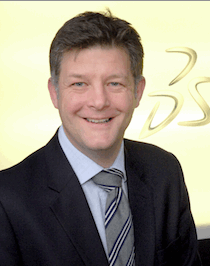Growing city populations present new opportunities for citizens, planners and the economy

Stephen Chadwick, Dassault Systèmes
Something historical happened at the beginning of 2015. For the first time in human history, the number of people living in cities was larger than the number of people living in rural areas, writes Stephen Chadwick, the managing director for EuroNorth at Dassault Systèmes.This watershed event in urbanisation comes at the same time as a shift in perception, where cities are being viewed as a catalyst for a sustainable lifestyle rather than a challenge. A couple of months ago, the National Research Foundation of Singapore announced that we will together develop the first, fully functional 3D model of an entire country. For the city-state, of around 5.3 million people, with a similar landmass to Greater London, this undertaking is expected to be finished within the next three years.
So what can you potentially do with a complete 3D virtual model? The goal of the project is to create a real-time visual presentation of data and simulation to show and predict thousands of variables important for city life, including migration patterns, climate effects and disaster/risk management. This information will be vital for business and government in planning new developments of housing and infrastructure, calculating risks and minimising the city’s environmental footprint by reducing negative factors such as traffic congestion, energy spill and importantly human stress. As in the classic game Sim City, but on a massive yet more granular scale, and with very real implications.
At home, by 2020 the UK’s city dwellers will account for more than 92% of the population. Up from an already high 79% in 1950. With political, financial and security consequences at stake there are growing information dis-junctions within and between city administrators and with the public they serve. Access to information, via a 3D city model would efficiently solve this problem by keeping people in synch with one another through a single source of information about their city.
In the past a great deal of technology has been used to help run our cities’ departments but unfortunately this has often led to making complex situations incompressible. The problem lies in the separate information stores, or silos, of data that inevitably arise when diverse systems cannot share their data. This means that planning can be based on out of date, incomplete and disjointed information that effectively misinforms stakeholders and the public.
The UK has £411bn of infrastructure projects in the pipeline 64% of which will be funded by the private sector. Using shared 3D experiences to simulate cities can reveal potential problems and solutions that may not be seen by any other means. Overlaying data reveals new views making it possible to actually predict events and their outcomes. Transport systems, and hubs, public services, utility provision and security along with the location and operation of everything within and beyond the city can be seen and understood by expert and non-expert alike. It makes complexity visible to investors, government, contractors and the public. Being able to simultaneously see a mass of details within the big picture also assists waste reduction by making it easier to spot. Because this helps make best use of pubic and private funds and resources its a political and business no-brainer which is rapidly gaining traction.
To be great places to live and work our constantly evolving cities must be efficiently run, economically viable and socially vibrant. They need order, freedom, and creativity within a secure local and national framework. New infrastructure developments that help Britain’s cities and citizens achieve their potential will be incredibly exciting and complex and I hope that experiences drawn from the Virtual Singapore project play an important part in their future.
